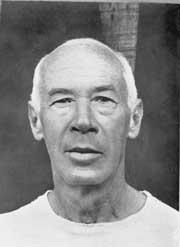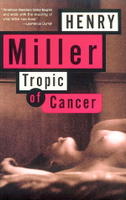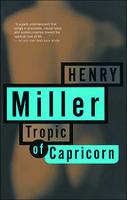Some Of The Books I've Been Reading This Summer -- Part #3
 To begin with, I must admit that I am biased. Henry Miller is easily my favorite author of all time. I have sought out the rare and out-of-print editions of his books both online, and in used bookstores all throughout the
To begin with, I must admit that I am biased. Henry Miller is easily my favorite author of all time. I have sought out the rare and out-of-print editions of his books both online, and in used bookstores all throughout the Henry Miller was an American original, and one of the most remarkable and memorable personalities among American writers of any era. In 1930, at the age of 38, he left
Some ten years later, after having written (and published) the two "Tropics" books which made him famous throughout
In the latter half of the 1940's and all through the 1950's – well before the “New Age” gurus introduced their guides to better living -- Miller was letting his soul and spirit run free, and he was writing about his life there, high above the Pacific ocean in the remote Big Sur area. This book is his account of those experiences, which occurred after his return from
“
 acceptance of today's hectic, violent, irrational world. It’s also essential reading for those who’ve read Miller’s early trilogy which contains his two “Tropics” books, and would like a better understanding of the man behind them -- two of the greatest and most controversial novels of all time.
acceptance of today's hectic, violent, irrational world. It’s also essential reading for those who’ve read Miller’s early trilogy which contains his two “Tropics” books, and would like a better understanding of the man behind them -- two of the greatest and most controversial novels of all time."This is my answer!" states Miller in the book's opening pages, and in this regard, Big Sur and the Oranges of Hieronymus Bosch is his “Walden,” because it was there, on the far west coast, far removed from his native New York, that Miller found the only home he could fully abide in America. He found a place where he felt he could live peaceably as a creative artist; a place set apart from the old, “normal” way of life that he viewed as thin and meaningless, a way of life which he had long since turned his back upon.
In
With occasional exceptions, such as extended return trips to Europe and New York, Miller would live there for nearly 18 years, writing his books, painting his watercolors, making friends, living (sequentially) with a couple of his several wives, and suffering visits from the occasional, unannounc
 ed fan! It is clear in reading this book, that the awesome beauty of
ed fan! It is clear in reading this book, that the awesome beauty of As is the case with many of Miller’s books, Big Sur is not a strict linear narrative but, rather, a collection of thoughts, reminiscences, hopes, loves, dreams, stories, and reveries. Indeed, the book has no central plot; in fact, it doesn't really pretend to have any forward momentum at all. The narrative just floats. As others have noted (either enthusiastically or bitterly), Henry Miller delivers, in this book, a seemingly random swirl of philosophy, wit, character studies, soaring observations of topography and weather, literary and art
 y musings, puzzles, koans, epigrams, aphorisms, scripture, historical trivia, astrological forecasts, and jokes.
y musings, puzzles, koans, epigrams, aphorisms, scripture, historical trivia, astrological forecasts, and jokes.This great book does not, upon first glance, seem to have any real point whatsoever. But that, of course, is the point. What Miller was laying out here (in a unique way, free of the usual jargon) is a meditation on how to live a different life, a vibrant life, a life of the spirit -- which, by definition, can only be expressed through a narrative that (like the life it describes) refuses to conform to the usual numbing standards of conduct. Upon a bit of reflection, one comes to recognize that such an expression, ultimately, was precisely what Jesus Christ (although in a rather different era and place) was attempting to do through his own teachings and his own life examples.
The core of this book -- what shines through most -- is the reality of the man, his unique viewpoint, and a wisdom born of spiritual freedom and real experience. This is not to be found in much of anything written today. Unlike today's a
 uthors, Henry Miller knew what it was like to live without money, to often be hungry, to be out on the street without a home, to be maligned, to turn against convention, and to subordinate all to art. Not everything that he did in his life can be considered honorable or noble. But he refused to be a pessimist or give up on life's possibilities. Optimism and hope were the two indomitable qualities at the very heart of Miller, which informed nearly all of his art.
uthors, Henry Miller knew what it was like to live without money, to often be hungry, to be out on the street without a home, to be maligned, to turn against convention, and to subordinate all to art. Not everything that he did in his life can be considered honorable or noble. But he refused to be a pessimist or give up on life's possibilities. Optimism and hope were the two indomitable qualities at the very heart of Miller, which informed nearly all of his art.The best elements of Miller’s character – his absolute love of life itself, his driven nature to be creative and to express himself, his transcendence of what others accept blindly, his pursuits of individuality and of an enlightened spirit fully at rest -- are this book's great gifts to its readers. For those ready for it, this book inspires, and one is made into a better person through learning the truths Miller lived by, and through coming to know the true paradise called
So, if you are looking for a traditional story, per se, then pass right on by “Big Sur” and keep driving until you get up to Monterey. Or, if you are looking for some of Henry Miller's famously invigorating foulness and fury, pick up Tropic of Cancer instead. If you are looking for peace, stop here.
Incidentally, if you ever do make it to the actual location of Big Sur, and you have any interest in Henry Miller or his books, be sure to check out the Henry Miller Memorial Library, which is a marvelous place to visit. I’d encourage all those who come to love Miller’s writings to offer some financial support to the Henry Miller Memorial Library.
--Spencer

0 Comments:
Post a Comment
<< Home